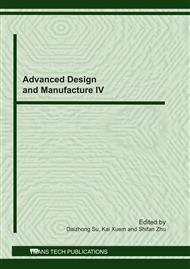p.111
p.115
p.119
p.123
p.127
p.131
p.135
p.139
p.143
Molecular Dynamics Simulation of Aluminium Thin Film Surface Activated Bonding
Abstract:
This study used molecular dynamics simulations with an embedded-atom method (EAM) potential to investigate the effect of surface roughness on the surface activated bonding (SAB) of aluminium thin films. The simulations started with the bonding process and followed by the tensile test for estimating bonding strength. By averaging the atomic stresses over the entire system, the stress-time curves for the bonded films under a tensile condition were predicted. Moreover, the evolution of the crystal structure in the local atomic order was examined by the common neighbour analysis. The simulated results show that the decrease in the surface roughness of thin film improves the bonding strength. The observed recrystallization processes inside the bonded thin films also reveal that the plastic deformation of the aluminium surface due to atomic attracting force compensates surface roughness.
Info:
Periodical:
Pages:
127-130
Citation:
Online since:
July 2011
Authors:
Price:
Сopyright:
© 2011 Trans Tech Publications Ltd. All Rights Reserved
Share:
Citation:


